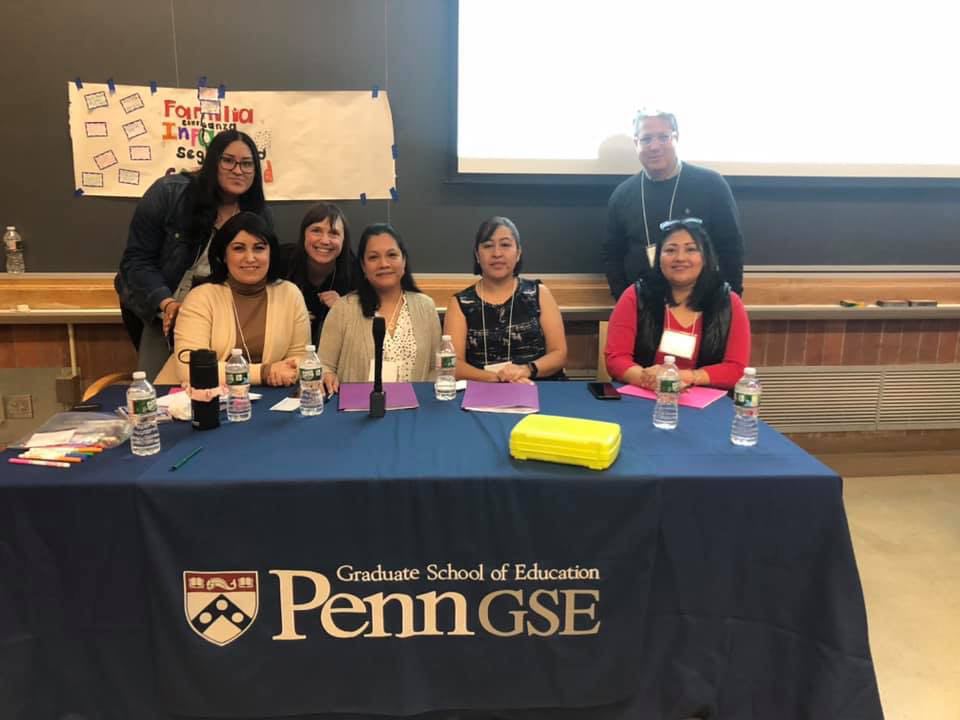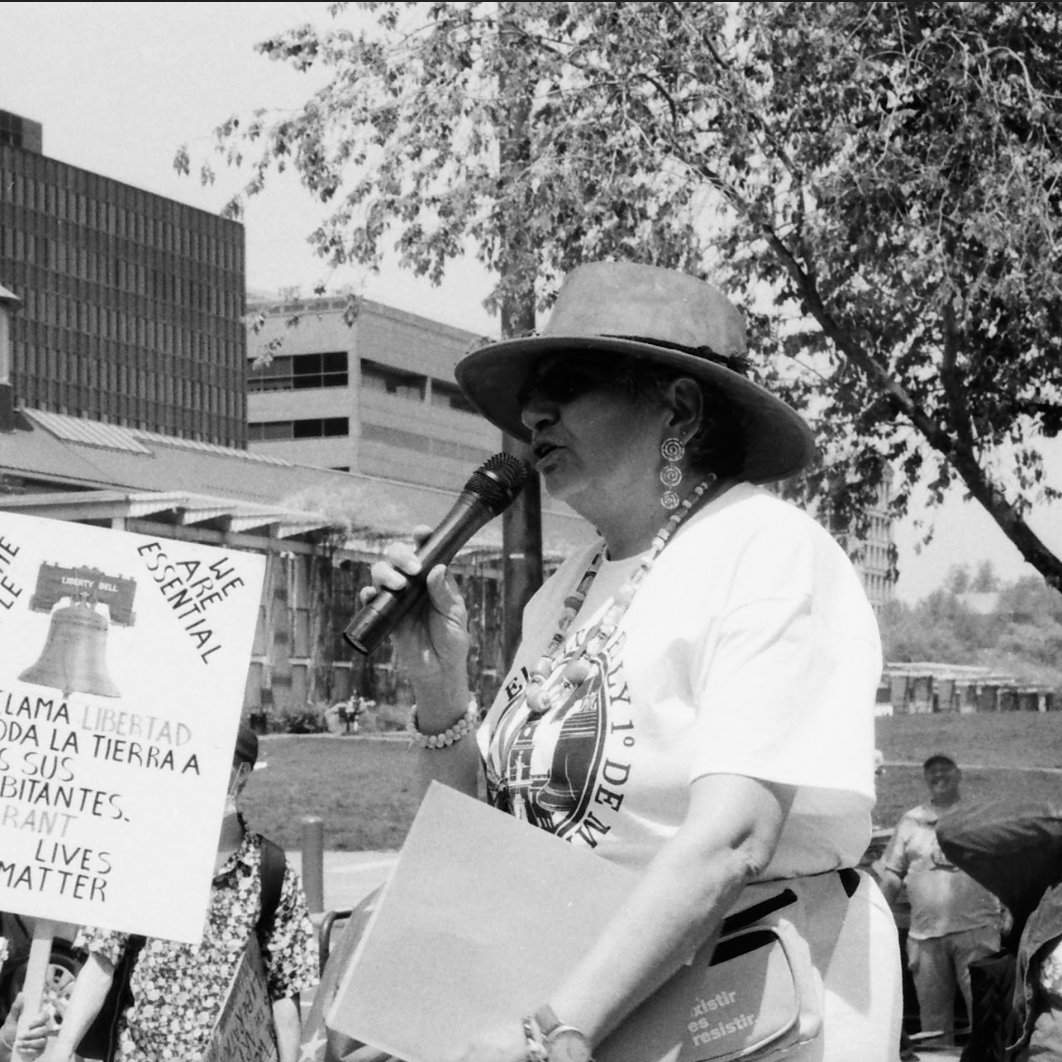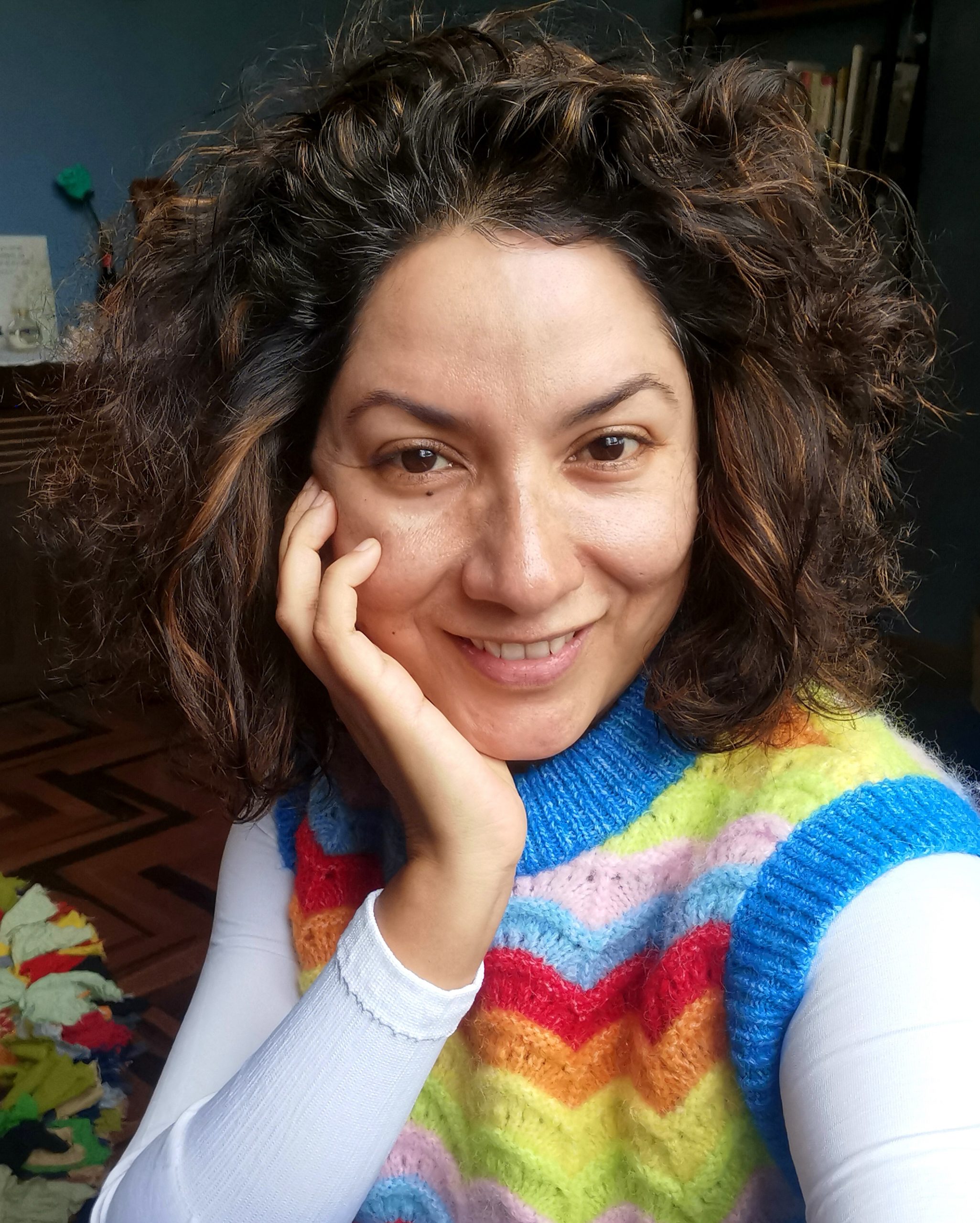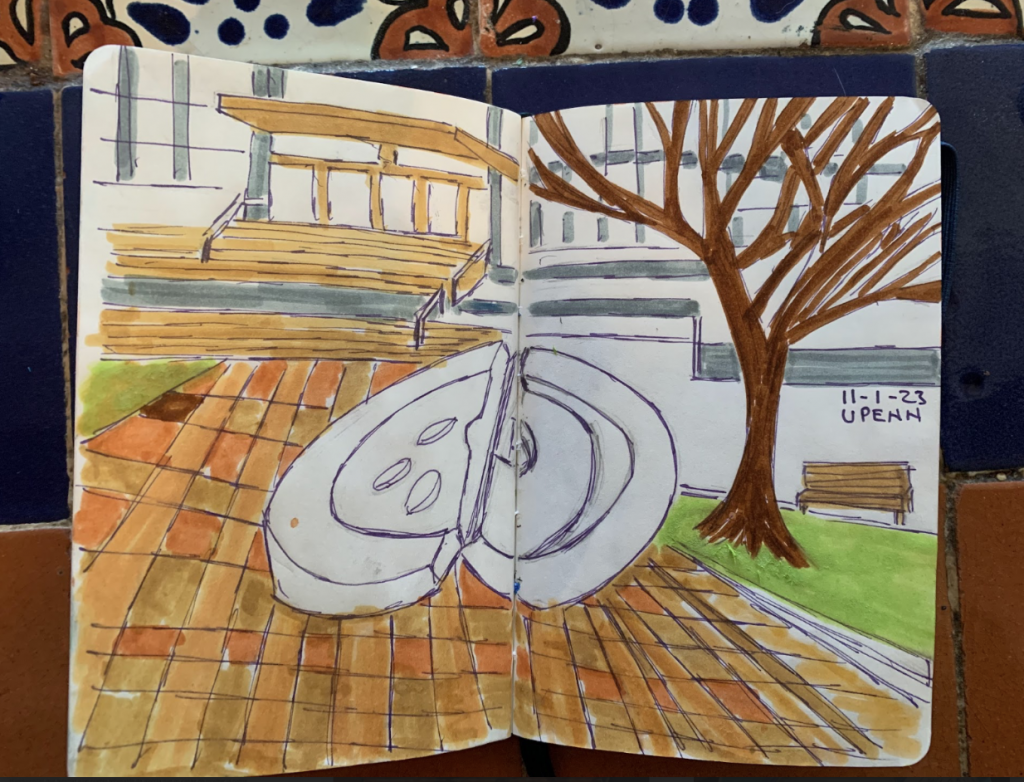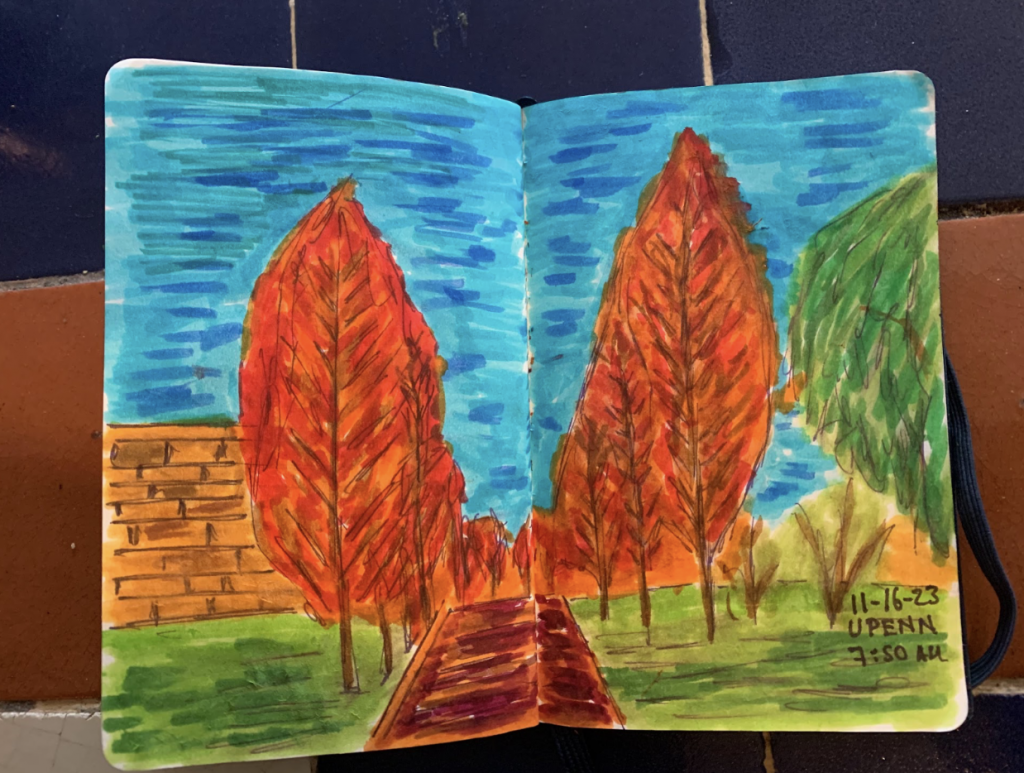Por Aura R. Cruz Aburto
Click here for English version
La mesa está puesta
Paisaje y viento. Un columpio al centro en forma de esfera hecha de alambre donde esperaba encontrar a Henry columpiándose, lo cual no sucedió para mi sorpresa.
Al lado de esta esfera estaba dispuesta una mesa alrededor de un fogón (ni tan) improvisado que estaba calentando un gran cazo de cobre y que despedía un olor fantástico.
La mesa tenía 7 sillas exactamente, un número que no era mero accidente sino un recuerdo frecuente de las aficiones cínico-simbólicas a las que el Henry era un aficionado: 6 discípulos, un número maligno de discípulos con la tensión del divino número total: el número 7. Ya justo en su cumpleaños número 66 había hecho la fiesta de onomástico más inolvidable. Esta vez seríamos 6 discípulos en la mesa y 1 maestro en la silla central que tenía frente un gran letrero que decía “Maestro Diablo”.
¡Ay “Maestro Diablo”! cómo no recordar el día que te hiciste de ese mote: casi morías atropellado por tu performance demostrativo de “cómo se cruzan las calles en México” y, para cuando estabas tendido en el suelo tras haber sido arrollado por un taxi, un pobre hombre se acercó desesperado a ver si respirabas y se puso a rezar hincado junto a tu cuerpo… entonces saltaste de un brinco y dijiste con tu voz ronca y con ese “szeszeo” tan característico de tu hablar: “Yo szoy el diablo” jajajaja.
Ahí estábamos frente a la mesa y fuimos tomando nuestros lugares. A tu derecha habías dispuesto un lugar para el elemental José Carlos. La verdad yo no entendía, de entrada, por qué habías elegido a un bruto como ese, pero bueno… he de decir que algo que siempre hiciste fue sorprenderme… A tu izquierda estaba yo, me dio gusto, ya sabes, soy zurda y me causaba gracia que quisieras molestarme diciéndome “siniestra”. Junto a mí estaba Lucy y, de frente a ella, estaba Valerio. Alexander y Adalberto, finalmente, habían quedado frente a tí… la mesa era de planta circular con un hueco al centro que contenía una especie de fogón que mantenía la comida caliente.
Alexander
No tardó en llegar Alexander, quien sabíamos que no disfrutaba particularmente de los encuentros multitudinarios, si bien era un gran pensador y conversador con quienes sentía cercanos. Aunque siempre había sido tan diferente a tí, él también sería un magnífico maestro. Recuerdo que cuando lo conocí era capaz de entrelazar y asociar ideas aparentemente imposibles de emparentar y, con ello, abrir todo un panorama de posibilidades. También era sin duda una “máquina” de referencias y lecturas… quizá, entonces, sólo le hacía falta hacer escuchar su voz que tímidamente asomaba como un tenue eco entre esas asociaciones inauditas.
Así, llegó Alexander, ataviado también de negro, pero no con ese negro estridentista como el de Adalberto, negro que con su ausencia de luz más que silencio sería un grito absoluto. En cambio, la manera en que Alexander se ataviaba de negro era el de un silencio visual radical que se asemejaba a su paso ligero, un paso que flota. Por eso digo que Alexander también sería un maestro pero sin el histrionismo de Henry ni la salvaje expresión de Adalberto, sino un maestro que enseñaba a ver de la arquitectura su comportamiento diagramático: las operaciones vitales a las que daría lugar así como aquellas a las que cancelaría, el quería sacar a la luz “el truco”. En este sentido, Alexander era una especie de antítesis de Adalberto y, aunque nunca negó el genio de éste, siempre dejó entrever que era un espíritu dominante. Alexander, en cambio, siempre más sutil, lo que hacía era fungir como un catalizador para que cada cual tuviera sus propias revelaciones, era un anarquista del pensamiento, un amante de la libertad radical. Creo que ahora que pienso en estos caracteres diferenciadores de Alexander y Adalberto –ellos también maestros como Henry– entiendo por qué fueron destinados a sentarse a la mesa, casi frente al lugar del “Diablo”.
Para ese momento de la cena, yo estaba muy contenta. Claro, me hacía falta Henry pero era maravilloso estar con mi mejor amiga y esos dos grandes y contrastantes maestros entrañables. Lucy siempre había sido mi cómplice, crecimos, padecimos y nos sorprendimos juntas. Adalberto, sin duda nos tenía deslumbradas y, bueno, habrá que decirlo ahora, lo seguirá haciendo en tanto genio revelador de las fuerzas creadoras del cosmos, aunque no necesariamente como individuo: cuando alguna vez estudié la figura del genio kantiana el rostro que vino a mi cabeza era el de ese señor mezquino que a la vez es capaz de un don inigualable para crear mundos nuevos que habitar. Probablemente por eso tiene los ojos desorbitados, lo atraviesa algo que, por supuesto, es más grande que su individualidad: la fuerza creadora de la vida.
Y bueno, qué decir de Alexander, ese maestro que es amigo, Amigo. Uno tal que como dice él, es un “Benjamin Button” en lo político: entre más años reúne, más radical se vuelve, en vez de más conservador como suele suceder. Y, curiosamente, Alexander también se conserva incomprensiblemente joven (no se lo digan a nadie, pero estoy segura que tiene un retrato escondido desastrosamente envejecido en un recóndito rincón de su apartamento.)
Después de un rato de estar plácidamente sentada, pletórica de alegría por estar junto a seres tan diversos y entrañables sonó el timbre de la Torre. Parece broma, pero el cielo se nubló un poquito y dejamos, por un momento, de ver el Sol de la tarde que caía sobre el bosque de Chapultepec que estaba frente a la Torre: llegó Valerio.
Pasiones tristes
Hacía ya unos años, Valerio me impactó con la “corrección de proyecto” más linda que había tenido hasta entonces como estudiante de arquitectura. En ese entonces estaba arrobada con la fuerza expresiva del art nouveau y su bellísimo organicismo, no tanto porque pretendiera reproducir a la naturaleza, que no lo hacía, sino de recuperar su gesto como fuerza, su gesto de “látigo”, de relámpago de vida. Valerio, a quien a partir de entonces llamamos Sensei, se limitó a compartir una historia:
Alguna vez existió un próspero rey en Venecia que mandó llamar a los mejores artistas de su ciudad y a los más destacados pintores chinos. Mandó construir dos muros, uno frente al otro, y colocó una cortina de terciopelo entre ellos. Tuvieron una semana para crear la más bella obra de arte jamás pensada en el muro que a cada uno tocó. Cuando llegó el momento, se corrió la cortina. Los artistas venecianos habían hecho el mural más deslumbrante, copioso de elementos, bellos pájaros y el dorado color del atardecer… casi cobraba vida. Los pintores chinos se limitaron a pulir su muro hasta convertirlo en un espejo que reflejaba el mural veneciano.
Ay Valerio, cómo explicarte el impacto que ese bello cuento, al que no tuviste que añadir nada, me dio y me sigue dando. Sin embargo, años más tarde, te reencontré como un joven-viejo (contrario al niño-viejito que solías decir que era Henry). No sé cómo esa sensibilidad lúcida y suave que te caracterizaba fue herida al grado de convertirse en renuncia y asqueo.
Ese día, Valerio llegó ataviado con su tradicional color gris. Con su gesto adusto nos saludó y se sentó un poco alejado y, bueno, trató de conversar con Alexander. A nosotras nos saludó con cierta displicencia y aparente sentido de superioridad… Nunca entendí porqué una persona a la que la vida podía tocar tanto, sólo retomó la fase destructiva de lo que supone vivir afectado: la impotencia.
Henry, es verdad, era una especie de Dionisio, ese dios griego de la sobreabundancia, del juego, del erotismo… nos mostraba que vivir era dejarse atravesar y mutar, y bueno, hay que decirlo, también tenía la cara de la pulsión de muerte… era el deseo encarnado en su doble aspecto: creación y destructividad. Y tú, Valerio, te quedaste con la pura pasión triste, con el desencanto. Valerio, el amargo.
English Version:
The Last Supper (II)
by Aura R. Cruz Aburto
The Table is Set
Landscape and wind. In the center, a spherical swing made of wire, where I expected to find Henry swinging, which to my surprise, did not happen. Beside this sphere, a table was arranged around a (not so) improvised fire pit that was heating a large copper cauldron, emitting a fantastic aroma. The table had exactly 7 chairs, a number that was not a mere coincidence but a frequent reminder of the cynico-symbolic hobbies Henry was fond of: 6 disciples, a malevolent number of disciples juxtaposed with the divine total number: 7. Precisely on his 66th birthday, he had thrown the most unforgettable name day party. This time, there would be 6 disciples at the table and 1 master in the central chair facing a large sign that read “Master Devil”.
Oh, “Master Devil”! How can I forget the day you earned that nickname: you almost died run over during your demonstrative performance of “how to cross streets in Mexico”, and as you lay on the ground after being hit by a taxi, a poor man rushed to see if you were breathing and began to pray kneeling next to your body… then you jumped up and said in your hoarse voice with that characteristic “szeszeo” in your speech: “I am the devil” haha.
There we were, in front of the table, taking our seats. To your right, you had arranged a place for the elemental José Carlos. Honestly, I didn’t understand at first why you had chosen someone as brutish as him, but well… I must say you always surprised me… To your left was I, I was pleased, you know, I’m left-handed and it amused me that you wanted to tease me by calling me “sinister”. Next to me was Lucy, and facing her, Valerio. Alexander and Adalberto were finally facing you… the table was circular with a hole in the center containing a kind of fire pit that kept the food warm.
Alexander
Alexander, who we knew did not particularly enjoy large gatherings, though a great thinker and conversationalist with those he felt close to, soon arrived. Although he had always been so different from you, he too would be a magnificent teacher. I remember when I met him, he was capable of intertwining and associating seemingly impossible ideas, thereby opening up a whole panorama of possibilities. He was undoubtedly a “machine” of references and readings… perhaps, then, all he needed was to make his voice heard, which timidly emerged like a faint echo among those unheard-of associations.
Thus, Alexander arrived, also dressed in black, but not in the ostentatious black of Adalberto, whose absence of light was more a scream than silence. Instead, the way Alexander wore black was a radical visual silence akin to his light, floating step. That’s why I say Alexander would also be a teacher, but without Henry’s histrionics or Adalberto’s wild expression, rather a teacher who taught to see the diagrammatic behavior of architecture: the vital operations it would give rise to and those it would cancel, he wanted to bring to light “the trick”. In this sense, Alexander was a kind of antithesis to Adalberto and, although he never denied the latter’s genius, he always suggested he was a dominant spirit. Alexander, more subtle, acted as a catalyst for each to have their own revelations, an anarchist of thought, a radical lover of freedom. Thinking about these distinguishing characters of Alexander and Adalberto – they too teachers like Henry – I understand why they were destined to sit at the table, almost facing the “Devil”.
At that moment of the dinner, I was very happy. Sure, I missed Henry, but it was wonderful to be with my best friend and those two great and contrasting beloved masters. Lucy had always been my accomplice, we grew up, suffered, and were amazed together. Adalberto, no doubt, dazzled us and, well, it must be said now, will continue to do so as a genius revealing the creative forces of the cosmos, though not necessarily as an individual: when I once studied Kant’s concept of genius, the face that came to my mind was that of that petty man who at the same time has an incomparable gift for creating new worlds to inhabit. Probably that’s why his eyes are bulging, something larger than his individuality traverses him: the creative force of life. And what about Alexander, that teacher who is a friend, Friend. One such that, as he says, is a “Benjamin Button” politically: the more years he gathers, the more radical he becomes, instead of more conservative as is often the case. And, curiously, Alexander also remains inexplicably young (don’t tell anyone, but I’m sure he has a hideously aged portrait hidden in a remote corner of his apartment.) After a while of sitting contentedly, brimming with joy at being together with such diverse and beloved beings, the bell of the Tower rang. It seems like a joke, but the sky clouded over a bit and for a moment, we lost sight of the afternoon Sun falling over the Chapultepec forest in front of the Tower: Valerio arrived.
Sorrowful Passions
Years ago, Valerio impressed me with the most beautiful “project correction” I had had so far as an architecture student. Back then, I was enamored with the expressive force of Art Nouveau and its beautiful organicism, not so much because it sought to reproduce nature, but because it sought to recover its gesture as a force, its gesture of “whiplash”, of a lightning bolt of life. Valerio, whom we thereafter called Sensei, simply shared a story:
Once there was a prosperous king in Venice who summoned the best artists of his city and the most outstanding Chinese painters. He had two walls built facing each other, with a velvet curtain between them. They had a week to create the most beautiful work of art ever conceived on the wall allotted to each. When the time came, the curtain was drawn. The Venetian artists had created the most dazzling mural, abundant with elements, beautiful birds, and the golden color of sunset… it almost came to life. The Chinese painters simply polished their wall until it became a mirror reflecting the Venetian mural.
Oh Valerio, how can I explain the impact that beautiful tale, to which you added nothing, had on me and continues to have. However, years later, I reencountered you as a young-old man (unlike the old-young boy you used to say Henry was). I don’t know how that lucid and gentle sensitivity that characterized you was wounded to the point of turning into renunciation and disgust. That day, Valerio arrived wearing his traditional gray color. With his stern gesture, he greeted us and sat a little apart, and, well, tried to converse with Alexander. He greeted us with a certain disdain and apparent sense of superiority… I never understood why someone so touched by life only took up the destructive phase of what it means to live affected: impotence. Henry, it’s true, was a kind of Dionysus, that Greek god of overabundance, play, eroticism… he showed us that to live was to let oneself be traversed and transformed, and, well, it must be said, he also had the face of the death drive… he was desire incarnate in its dual aspect: creation and destructiveness. And you, Valerio, were left with mere sorrowful passion, with disenchantment. Valerio, the bitter.
Aura R. Cruz Aburto
Aura es filósofa mexicana, latinoamericana orgullosa, es también artista espacial, textil y visual que busca dar de cuando en cuando con “la frágil unidad poética”. Profesora de la Universidad Nacional Autónoma de México, Tec de Monterrey e investigadora independiente.
Selected Works by Aura R. Cruz Aburto:
La Última Cena (I)
